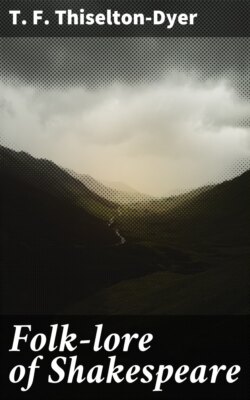Читать книгу Folk-lore of Shakespeare - T. F. Thiselton-Dyer - Страница 7
На сайте Литреса книга снята с продажи.
Footnote
ОглавлениеTable of Contents
[1] “Illustrations of the Fairy Mythology of ‘A Midsummer-Night’s Dream,’” 1845, p. xiii.
[2] “Fairy Mythology,” p. 325.
[3] Aldis Wright’s “Midsummer-Night’s Dream,” 1877, Preface, pp. xv., xvi.; Ritson’s “Fairy Mythology,” 1875, pp. 22, 23.
[4] Essay on Fairies in “Fairy Mythology of Shakspeare,” p. 23.
[5] “Fairy Mythology,” 1878, p. 325.
[6] Notes to “A Midsummer-Night’s Dream,” by Aldis Wright, 1877, Preface, p. xvi.
[7] “Three Notelets on Shakespeare,” pp. 100-107.
[8] See Croker’s “Fairy Legends of South of Ireland,” 1862, p. 135.
[9] “Fairy Mythology,” 1878, p. 316.
[10] Wirt Sikes’s “British Goblins,” 1880, p. 20.
[11] This is reprinted in Hazlitt’s “Fairy Tales, Legends, and Romances, illustrating Shakespeare and other English Writers,” 1875, p. 173.
[12] “Illustrations of the Fairy Mythology of the Midsummer-Night’s Dream,” printed for the Shakespeare Society, p. viii.
[13] See Brand’s “Pop. Antiq.,” 1849, vol. ii. pp. 508-512.
[14] Thoms’s “Three Notelets on Shakespeare,” p. 88.
[15] See Nares’s Glossary, vol. ii. p. 695.
[16] Mr. Dyce considers that Lob is descriptive of the contrast between Puck’s square figure and the airy shapes of the other fairies.
[17] “Deutsche Mythologie,” p. 492.
[18] See Keightley’s “Fairy Mythology,” pp. 318, 319.
[19] “Three Notelets on Shakespeare,” pp. 79-82.
[20] Showing, as Mr. Ritson says, that they never ate.
[21] “Letters on Demonology and Witchcraft,” 1831, p. 121.
[22] “Illustrations of Shakespeare,” p. 115.
[23] “Elizabethan Demonology,” p. 50.
[24] Agate was used metaphorically for a very diminutive person, in allusion to the small figures cut in agate for rings. In “2 Henry IV.” (i. 2), Falstaff says: “I was never manned with an agate till now; but I will inset you neither in gold nor silver, but in vile apparel, and send you back again to your master, for a jewel.” In “Much Ado About Nothing” (iii. 1) Hero speaks of a man as being “low, an agate very vilely cut.”
[25] See Grimm’s “Deutsche Mythologie.”
[26] Thoms’s “Three Notelets on Shakespeare,” 1865, pp. 38, 39.
[27] See Keightley’s “Fairy Mythology,” 1878, p. 208.
[28] See also Thorpe’s “Northern Mythology,” 1852, vol. iii. p. 32, etc.
[29] Gunyon’s “Illustrations of Scottish History, Life, and Superstitions,” p. 299.
[30] Chambers’s “Book of Days,” vol. i. p. 671.
[31] Among the various conjectures as to the cause of these verdant circles, some have ascribed them to lightning; others maintained that they are occasioned by ants. See Miss Baker’s “Northamptonshire Glossary,” vol. i. p. 218; Brand’s “Pop. Antiq.,” 1849, vol. ii. pp. 480-483; and also the “Phytologist,” 1862, pp. 236-238.
[32] Douce’s “Illustrations of Shakespeare,” p. 112.
[33] Ritson’s “Fairy Mythology,” 1878, pp. 26, 27.
[34] Quoted by Brand, “Pop. Antiq.,” vol. ii. p. 481.
[35] Brand’s “Pop. Antiq.,” 1849, vol. ii. p. 483.
[36] Halliwell-Phillipps’s “Illustrations of Fairy Mythology,” p. 167; see Douce’s “Illustrations of Shakespeare,” pp. 122, 123.
[37] “Illustrations of Shakespeare,” pp. 126, 127.
[38] See Croker’s “Fairy Legends and Traditions of the South of Ireland,” p. 316.
[39] See Brand’s “Pop. Antiq.,” vol. ii. p. 493.
[40] Ritson’s “Fairy Mythology of Shakespeare,” 1875, p. 29.
[41] Some copies read them.
[42] We may compare Banquo’s words in “Macbeth” (ii. 1):
“Restrain in me the cursed thoughts that nature
Gives way to in repose.”
[43] “Fairy Mythology,” pp. 27, 28.
[44] “Comedy of Errors” (iv. 2) some critics read:
“A fiend, a fairy, pitiless and rough.”
[45] This superstition is fully described in chapter on Birth.
